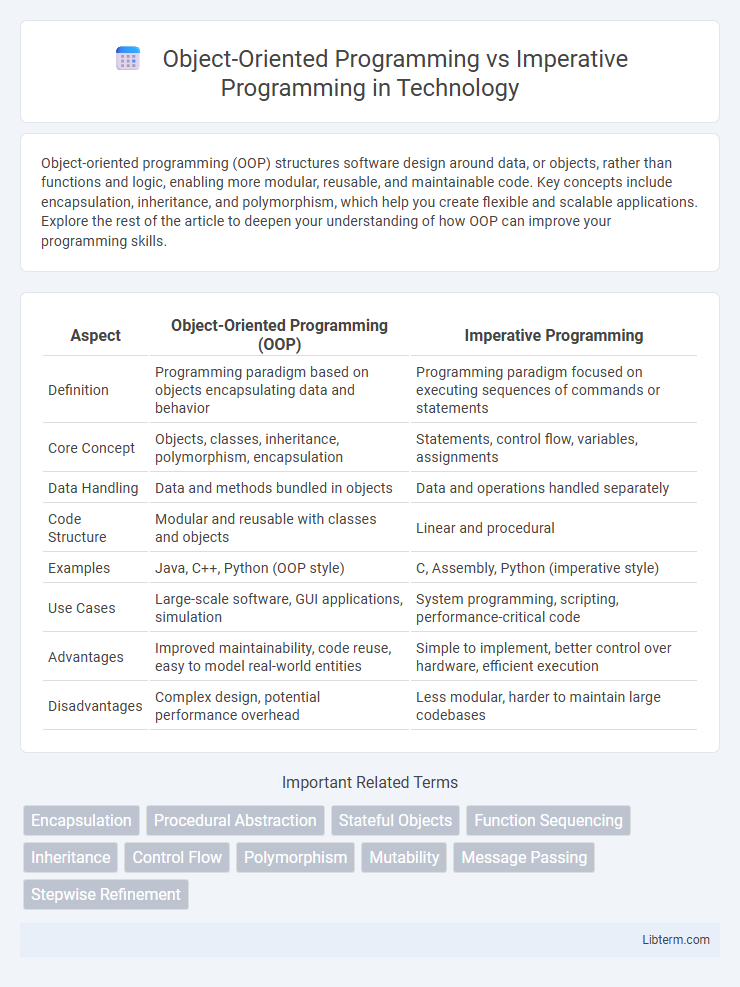Object-oriented programming (OOP) structures software design around data, or objects, rather than functions and logic, enabling more modular, reusable, and maintainable code. Key concepts include encapsulation, inheritance, and polymorphism, which help you create flexible and scalable applications. Explore the rest of the article to deepen your understanding of how OOP can improve your programming skills.
Table of Comparison
| Aspect | Object-Oriented Programming (OOP) | Imperative Programming |
|---|---|---|
| Definition | Programming paradigm based on objects encapsulating data and behavior | Programming paradigm focused on executing sequences of commands or statements |
| Core Concept | Objects, classes, inheritance, polymorphism, encapsulation | Statements, control flow, variables, assignments |
| Data Handling | Data and methods bundled in objects | Data and operations handled separately |
| Code Structure | Modular and reusable with classes and objects | Linear and procedural |
| Examples | Java, C++, Python (OOP style) | C, Assembly, Python (imperative style) |
| Use Cases | Large-scale software, GUI applications, simulation | System programming, scripting, performance-critical code |
| Advantages | Improved maintainability, code reuse, easy to model real-world entities | Simple to implement, better control over hardware, efficient execution |
| Disadvantages | Complex design, potential performance overhead | Less modular, harder to maintain large codebases |
Introduction to Programming Paradigms
Object-Oriented Programming (OOP) organizes code using classes and objects to model real-world entities, promoting encapsulation, inheritance, and polymorphism. Imperative Programming focuses on explicit instructions and state changes through statements and control flow to achieve desired outcomes. Both paradigms serve as foundational approaches in programming, influencing software design, maintainability, and problem-solving strategies.
Defining Object-Oriented Programming
Object-Oriented Programming (OOP) is a programming paradigm centered on creating objects that encapsulate both data and behaviors, enabling modular, reusable, and scalable code. It relies on key concepts such as classes, inheritance, polymorphism, and encapsulation to model real-world entities and facilitate abstraction. OOP contrasts with Imperative Programming, which focuses on explicit step-by-step instructions to change program state without necessarily organizing code around data structures.
Understanding Imperative Programming
Imperative programming centers on explicit commands that change a program's state through statements, loops, and conditionals, emphasizing how tasks are performed step-by-step. It contrasts with object-oriented programming by focusing on procedures rather than data models and abstractions like classes or objects. Key languages supporting imperative programming include C, Fortran, and assembly language, widely used for their control over hardware and performance optimization.
Core Principles: OOP vs Imperative Approaches
Object-Oriented Programming (OOP) centers on encapsulation, inheritance, and polymorphism to model real-world entities as objects with attributes and behaviors, promoting modularity and code reuse. Imperative Programming emphasizes a sequence of commands or statements that change program state through variables and control structures, focusing on how tasks are performed step-by-step. Core principles in OOP foster abstraction and data hiding, while imperative approaches prioritize explicit control flow and state manipulation.
Code Structure and Organization
Object-Oriented Programming (OOP) organizes code into classes and objects, promoting modularity and reusability through encapsulation, inheritance, and polymorphism. Imperative Programming structures code as a sequence of explicit statements that change program state, often using procedures or functions to organize instructions. OOP's hierarchical and declarative nature contrasts with the linear, step-by-step flow typical of imperative code structure.
Data Management and State Handling
Object-Oriented Programming (OOP) emphasizes encapsulating data within objects, enabling state management through methods that control data access and modifications, which promotes modularity and reusability. Imperative Programming focuses on explicit instructions that manipulate program state directly through variables and control structures, resulting in more straightforward but less modular state handling. OOP's approach to data management centralizes state within objects, whereas Imperative Programming manages state as a sequence of changes across variables and memory locations.
Reusability and Modularity
Object-Oriented Programming (OOP) enhances reusability through encapsulation and inheritance, allowing developers to create reusable classes and objects that can be extended or modified without altering existing code. Imperative Programming focuses on sequential statements and procedures, where modularity is achieved by breaking code into functions but often lacks the inherent hierarchy and abstraction that OOP provides. The modular design in OOP leads to easier maintenance and scalability by promoting code reuse across different parts of a program or multiple projects.
Real-World Use Cases
Object-Oriented Programming (OOP) excels in modeling complex systems like graphical user interfaces and game development by encapsulating data and behavior into objects, promoting modularity and reusability. Imperative Programming is commonly used in performance-critical applications such as embedded systems and system scripts, where direct control of state changes and sequential commands optimize resource management. Real-world projects benefit from combining OOP's abstraction with imperative control flow to balance maintainability and execution efficiency.
Performance Considerations
Object-Oriented Programming (OOP) often incurs performance overhead due to features like dynamic dispatch and extensive use of objects, which can lead to increased memory consumption and slower execution compared to Imperative Programming. Imperative Programming, with its straightforward sequence of commands and minimal abstraction, typically achieves faster runtime speeds and lower latency by emphasizing direct hardware manipulation and reduced pointer indirection. Performance-critical applications, such as system kernels or real-time processing, frequently prefer imperative paradigms for their efficiency, while OOP is favored for maintainability and scalability despite potential trade-offs in speed.
Choosing the Right Paradigm
Choosing the right programming paradigm depends on the project requirements and team expertise. Object-Oriented Programming (OOP) excels in managing complex systems by organizing code into reusable objects with encapsulated data and behavior, ideal for large-scale software with evolving features. Imperative Programming focuses on explicit control flow and state changes, offering simplicity and fine-grained control, making it suitable for performance-critical applications and straightforward tasks.
Object-Oriented Programming Infographic

 libterm.com
libterm.com